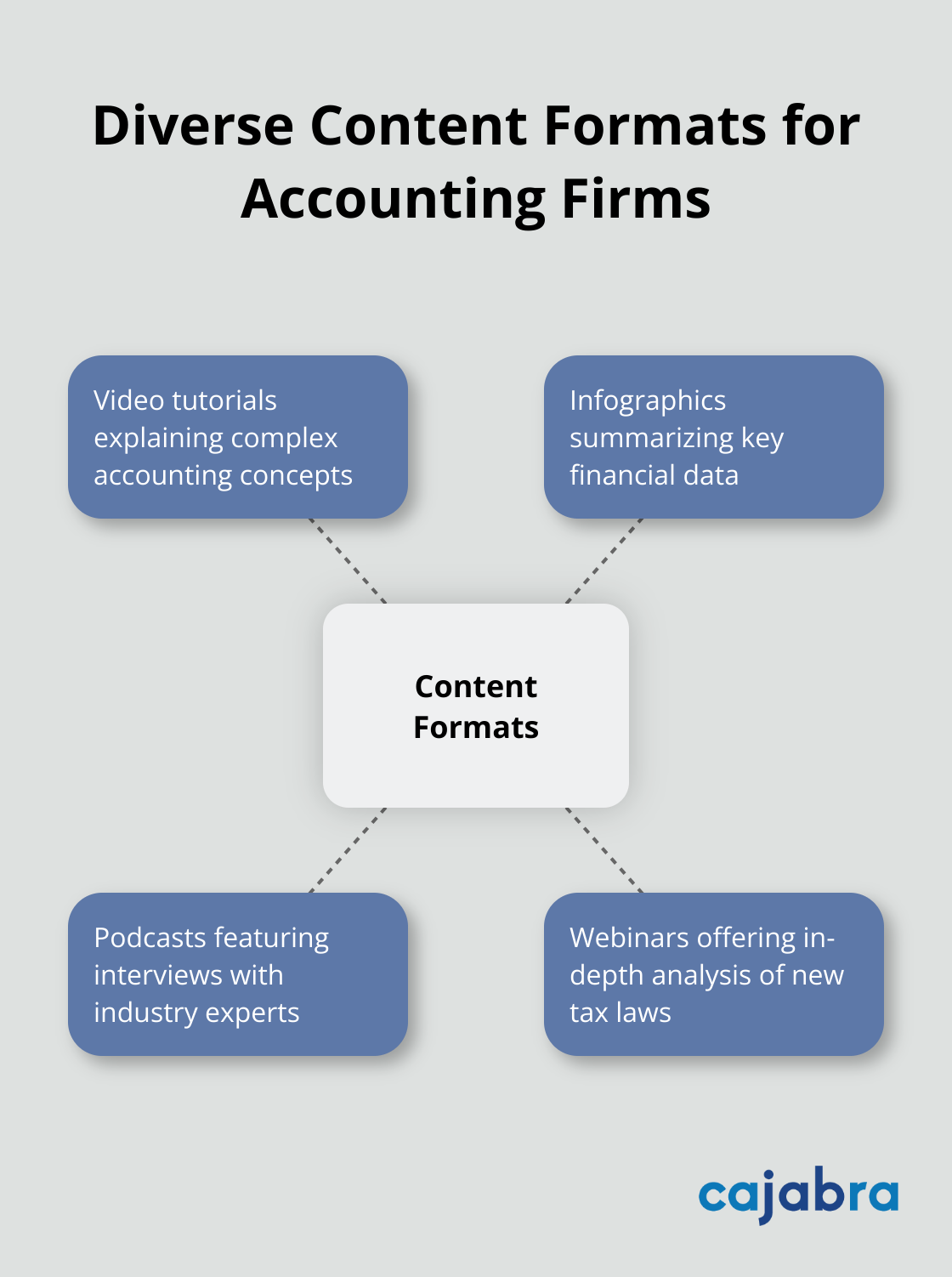
A well-crafted content strategy plan template is the backbone of successful digital marketing. At Cajabra, LLC, we've seen firsthand how it can transform a company's online presence and drive real results.
In this post, we'll guide you through creating a winning content strategy plan template that will help you achieve your marketing goals. We'll cover everything from setting clear objectives to implementing effective distribution tactics, giving you the tools you need to succeed.
The first step in setting your content strategy goals is to identify your target audience. This goes beyond basic demographics. You need to understand their pain points, desires, and online behavior. Use tools like Google Analytics to gather data on your website visitors. Conduct surveys or interviews with your existing clients to gain deeper insights. For accounting firms, this might mean understanding the specific challenges faced by small business owners or high-net-worth individuals.
Your content strategy goals should be Specific, Measurable, Achievable, Relevant, and Time-bound (SMART). SMART goal setting can help you build strategic goals that support success. Each accounting firm and tax practice has its own definition of success, so it's important to tailor your objectives accordingly.
Your content strategy shouldn't exist in a vacuum. It needs to support your overall business objectives. If your accounting firm's goal is to increase revenue from advisory services by 20% this year, your content strategy should focus on educating clients about the value of these services and position your firm as an expert in this area.
Before you set new goals, it's important to assess your current content landscape. Perform a content audit to identify what's working well and what needs improvement. This process will help you uncover gaps in your content and opportunities for optimization. Identify the content types that excel, such as blog posts, videos, or social media, and consider whether those findings offer ideas for your own strategy.
To measure the success of your content strategy, you need to define clear KPIs. These might include metrics such as organic traffic growth, engagement rates, lead generation, or conversion rates. Choose KPIs that directly relate to your business goals and provide actionable insights.
A well-defined content strategy isn't just about creating more content. It's about creating the right content that moves your business forward. With clear, measurable goals that align with your business objectives and resonate with your target audience, you're ready to move on to the next crucial step: developing your content creation process.
A content calendar serves as the foundation of your content creation process. It aligns your content with business goals and audience needs. Map out key dates, industry events, and seasonal trends relevant to your accounting firm. Plan your content topics around these milestones.
For example, an accounting firm might plan content about tax preparation tips in the months leading up to tax season. Tools like Trello or Asana can create a visual content calendar that your entire team can access and update in real-time.
Your content themes should reflect your expertise and address your audience's pain points. For accounting firms, themes might include tax planning strategies, financial reporting best practices, or business growth tips. Try to create a mix of evergreen content (always relevant) and timely pieces (addressing current events or changes in regulations).
A Content Marketing Institute survey revealed that 65% of the most successful content marketers have a documented content strategy compared to less successful marketers. This fact underscores the importance of planning your themes and topics in advance.

Diversify your content formats to cater to different learning styles and preferences within your audience. While blog posts are a staple, consider incorporating:
Content Formats
Repurpose your content across different formats to maximize its reach and impact. When you repurpose your content, change the format or adapt it to the channel where you plan to publish. For example, take a virtual event and transform it into multiple formats, extending its lifespan and value.
Clear role definition facilitates a smooth content creation process. Designate specific team members for content ideation, writing, editing, design, and distribution. If you're a smaller firm, you might wear multiple hats, but it's still important to clearly define each step of the process.
A project management tool can track tasks and deadlines (ensuring accountability and preventing bottlenecks in your content pipeline). Regular team meetings to discuss content performance and brainstorm new ideas can also keep your strategy fresh and aligned with your goals.
This systematic approach not only saves time and resources but also ensures that every piece of content contributes to your overall marketing objectives. The next step in your content strategy journey involves implementing effective distribution and promotion tactics to maximize the reach and impact of your carefully crafted content.
Creating great content is only half the battle. The real challenge lies in getting your content in front of the right eyes. Let's explore some effective strategies to amplify your content's reach and impact.
Don't put all your eggs in one basket. Spread your content across various platforms to maximize visibility. For accounting firms, LinkedIn often proves a goldmine for professional connections. Share your insights, engage with industry discussions, and post your content regularly. Twitter excels for quick updates on tax laws or financial news. Facebook and Instagram, while less formal, can help humanize your brand and showcase your company culture.
Email remains one of the most effective ways to reach your audience directly. A study by the Data & Marketing Association found that email marketing yields an average ROI of £42 for every £1 spent according to the latest 2025 statistics. Build a robust email list and segment it based on client interests or needs. Send regular newsletters with your latest content, industry updates, and valuable tips. Personalize your emails to increase open rates and engagement.

Search engine optimization (SEO) is essential for long-term content visibility. Research relevant keywords in the accounting and finance sector. Use tools like SEMrush or Ahrefs to identify high-value keywords. Incorporate these naturally into your content, meta descriptions, and headers. Focus on creating comprehensive, authoritative content that answers your audience's questions. This approach not only pleases search engines but also provides real value to your readers.
While organic reach is ideal, sometimes a little boost can go a long way. Consider allocating a portion of your marketing budget to paid promotion. LinkedIn Ads can be particularly effective for B2B services like accounting (you can target specific job titles, industries, or even companies). Google Ads can help you appear at the top of search results for competitive keywords. Start with a small budget, test different ad formats and targeting options, and scale based on performance.
The key to effective distribution is consistency and analysis. Regularly review your analytics to understand which channels and tactics drive the most engagement and conversions. Adjust your strategy accordingly, and don't fear experimenting with new platforms or formats. A well-executed distribution plan will ensure your carefully crafted content reaches the right audience and delivers measurable results for your accounting firm.
A content strategy plan template transforms how accounting firms market their services online. It helps define clear goals, streamline content creation, and maximize distribution. The template requires regular evaluation and adjustment to maintain its effectiveness and deliver value to your audience while aligning with business objectives.
We developed the JAB System™ to help accountants secure retainer-based clients. Our specialized marketing services allow you to focus on serving your clients while we handle digital marketing complexities. A well-crafted content strategy plan template will drive your firm's growth and establish you as an industry thought leader.
Your content strategy plan template is a powerful tool that can elevate your firm's digital presence. It will help you create impactful content, reach your target audience, and achieve your marketing goals. Start building your template today and watch your online presence flourish.



